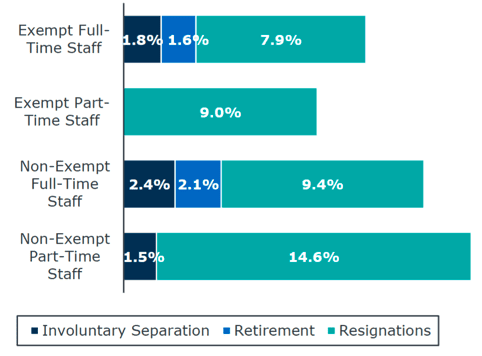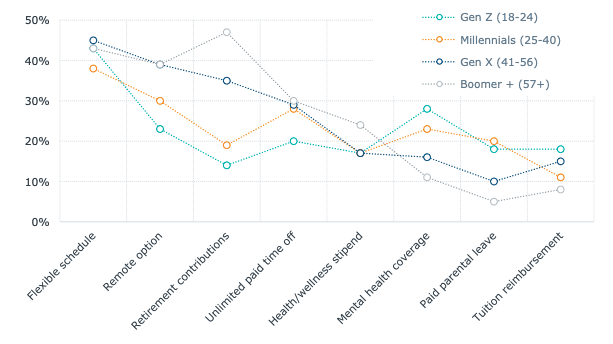3 ways to attract and retain community college staff amid the talent crisis
September 22, 2022, By Tara Zirkel, Director, Strategic Research
Any of us that have worked at an understaffed community college know that even one vacancy, let alone multiple, can slow student services to a halt. These disruptions in delivering critical supports may not only exacerbate existing enrollment declines, but they also stand to disproportionally impact first-generation and low-income students who often need the most help.
As staff members on campus are forced to take on larger workloads, and enrollments continue to dip, innovating on how to attract and retain talent is critical for stabilizing institutions moving forward. In this post, I’ll explore community college staffing trends and offer three ways to attract and retain staff.
The community college talent crunch
Community colleges are still recovering from the impacts of the pandemic, including decreased enrollment, escalating student mental health needs, and most recently, a shrinking workforce. Over 47 million people in the US voluntarily left their jobs in 2021, citing unhappiness, low pay, and lack of work/life balance as key causes. Since 2020, higher education has lost 65,000 jobs, the majority of which have been via resignations and retirements.
Community colleges have been especially hard hit, showing a 13% staff decline from 2020-2022, resulting in failed searches, difficulty filling part time positions, and shortages in student services positions.
Surge in higher ed staff turnover in the last year largely voluntary
Rate of and reasons for staff turnover, 2020-2021 (source: CUPA-HR)

Nationally, financial aid offices are especially feeling the resignation pinch, which is alarming given that community college students cite financial constraints as one their biggest barriers. A recent NASFAA survey shows that financial aid offices are understaffed, having difficulty hiring, and have concerns about meeting the needs of students.
NASFAA survey shows troubling vital stats for financial aid teams
56%
concerned over ability to meet the needs of students given current staffing levels43%
Report a high degree of difficulty filling open positions with qualified staff39%
unable to remain compliant with Education Department administrative capability requirements3 ways to attract and retain talent
1. Elevate your holistic benefits
Some of the best benefits I’ve ever had were while working at community colleges. While on campus I benefitted from tuition reimbursement, an excellent 401k match, high quality health insurance, ample time off, and professional development opportunities. My peers had paid parental leave, on-campus childcare options, and tuition waivers for their partners and dependents. This 360-degree approach to compensation packages is in strong demand, across all generations of workers.
Which benefits matter most to prospective employees?
% of surveyed individuals identifying benefits as having the “most influence,” by age (source: Fortune)

Often, community college job postings open with a list of duties and competencies rather than an introduction to the institution and why it’s a great place to work. Leading with a boilerplate statement showing your holistic benefits in job postings, human resources pages, and recruitment materials will help you stand out to applicants.
Tell a story about an employee who has children enrolled at the college, or someone who used tuition benefits to complete their degree. Make time to champion your mission, culture, benefits, and impact to generate excitement before jumping into the nuts and bolts of the position.
2. Share a clear path to career growth
Two main reasons why talent leaves are lack of a clear advancement opportunities (63%) and feeling they are being treated disrespectfully (57%). When we look at community college leaders and long-term faculty members who have built their careers entirely by advancing in the two-year sector it’s clear that there are pathways to more responsibility, and greater pay. Ways to showcase your commitment to career advancement include:
- Time off for professional development
- Tuition reimbursement and access to free professional development opportunities, especially if they lead to a credential or badge
- Profiling the career progressions of senior leaders
- In-house leadership development programs that allow people to learn from their peers
- Clearly stating what types of upskilling and professional development can lead to promotion opportunities
- Mentorship initiatives that link seasoned professionals to emerging professionals
Lastly, many community colleges use standardized pay grades and job classification rubrics. Sometimes, employees may be able to move laterally within a grade with minimal interference. Since there is a correlation between offering lateral opportunities and employee retention, even more so than compensation and promotion, this strategy can offer ways to retain talent even when budgets are tight.
Staff place a high value on lateral opportunities
Source: MIT Sloane Management Review

For example, say you have an open position for an admissions navigator, and someone in a similar TRIO coaching role wants to shift their career to enrollment management. Offering the potential for a lateral change may keep an employee short term, while also setting them up for long term retention.
3. Develop remote and flex work options
Like students, workers are citing flexible schedules and remote work options as one of their top expectations when searching for new positions. The pandemic taught us many things, one of which being that remote and flexible work might not only be possible in community colleges, but a benefit. Community colleges led the way in pivoting quickly to flexible options during the pandemic, and those strategies are equally as important to your workforce.
As you consider infusing more flexibility and remote options into your culture, these guiding questions can help you shape how your team divides their time. You may find that only half of a person’s responsibilities are place-, time-, or season-bound, freeing up part of their time for remote and flex options. Look at your job descriptions to determine:
- Which activities are place-bound?
- Which activities are time-bound?
- Which activities would be streamlined or eliminated with technology support?
- Which activities have seasonal constraints (e.g., orientation, the week before fall classes)
Lastly, examining in-person activities that are low impact, or could be augmented with tech support, and removing them from your team’s plate will help reduce their need to be on campus. For example, a staff member could spend five hours a week manually printing letters to students, which could be managed through an automated process. Or, your admissions office may staff multiple people to manage walk in students during low traffic times.
Act quickly to reverse talent loss
Given current staffing difficulties, and a projected six million worker deficient by 2028, it’s urgent that community colleges act quickly to reverse talent loss. While the obstacles are challenging, there are things you can do to soften the impact, and to plan for the future. Along with investing in technology to build efficiency, elevating your full suite of benefits, highlighting career pathways, and embracing workplace flexibility are all building blocks in hiring and retaining talent.

More Blogs

Four ways community colleges can improve career readiness

Boost student engagement with data and easy-to-use technology

4 strategies to bridge the skills gap between community college and career
Great to see you today! What can I do for you?